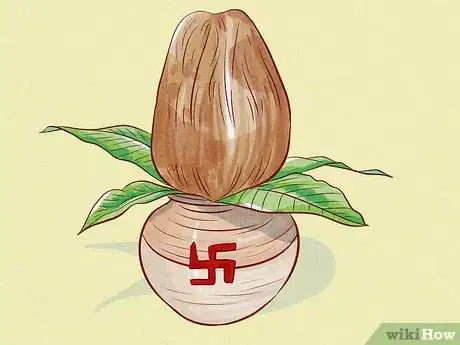This article was co-authored by wikiHow Staff. Our trained team of editors and researchers validate articles for accuracy and comprehensiveness. wikiHow's Content Management Team carefully monitors the work from our editorial staff to ensure that each article is backed by trusted research and meets our high quality standards.
There are 8 references cited in this article, which can be found at the bottom of the page.
This article has been viewed 108,770 times.
Learn more...
Saraswati is the Hindu Goddess of all learning and art forms. Saraswati is often worshipped by students, professionals, artists, and musicians seeking artistic and technical skills, academic strengths, wisdom, and good health. The Saraswati puja is performed on the Hindu holidays Vasant Panchami and Navratri, and you can perform a Saraswati puja in your home any time you want to call on Goddess Saraswati. To do the ritual, wake up early and take a bath, clean your home, set up your idol and kalash, chant the mantra, and complete the offering.
Steps
Performing Morning Rituals
-
1Wake up between 5:00 - 8:00 a.m. When performing the Saraswati puja at home, waking up early in the day is traditional practice. You can set an alarm for 5:00 - 8:00 a.m., or you can wake up when the sunshine comes through your window.[1]
- Give yourself at least 1 hour to complete the ritual, though some people spend longer.
-
2Rub a paste made of neem and turmeric over all of your body. To make the paste, soak 20 or so neem leaves in hot water until they are soft, strain the leaves, and then grind the leaves with a mortar and pestle. Then, pour in about ¼ teaspoon (1.23 g) of ground turmeric into the mortar and pestle. Grind up the paste, then rub a thin, even layer over your face, chest, arms, torso, and legs.[2]
- This paste is believed to have therapeutic and medicinal effects. For example, neem and turmeric paste works great to treat acne and maintain healthy skin.
- Make more paste as needed.
Advertisement -
3Soak in a bath with neem and tulsi leaves. After you’ve applied the neem and turmeric paste over your body, fill up your bathtub with warm water, and sprinkle 1–3 grams (0.035–0.11 oz) of both neem and tulsi leaves into the water. Soak in the tub for 15-30 minutes, and scrub off the neem and turmeric paste.
- The bath purifies the body and protects you against infection.
-
4Wear white or yellow colored clothing. After your bath, it is custom to dress in these hues to perform the puja. You can wear a pair of pants, a skirt, a blouse, or a dress in these hues.[3]
- Typically, those performing the puja dress in 1 of these colors, rather than dressing with some hues of both. For example, you may dress head-to-toe in white linens or you may adorn yourself in yellow clothing.
- Yellow is the color of knowledge and learning in Hinduism.[4]
- White represents purity, peace, and knowledge.[5]
Setting up the Idol and Kalash
-
1Clean your home the day before you perform the Saraswati puja. Before you perform the puja, clean your house thoroughly. Tidy up your spaces, and in particular, arrange all of your books upright on your shelves. Use a natural cleaning product like castile soap, vinegar solution, or essential oil to clean your tools, computer, and laptop.[6]
- If you can’t clean the day before, do this after you purify yourself.
- If you are performing the puja as part of your Navratri celebration, everything must be cleaned by the 8th day of Navratri.
- If you can't use natural cleaning products, you can use an all-purpose cleaner. Natural cleaning products are safer for the environment and more pleasing to Goddess Saraswati than harsh chemicals.
- Since Saraswati is the Goddess of learning, it is suggested that she appreciates arranging your library properly.
-
2Lay a white cloth on a raised platform and place your idol on top. This is the base of your altar. You can use any piece of white fabric, such as silk or linen. Smooth out the cloth with your hand so there are no folds or wrinkles. Then, place your idol of Goddess Saraswati in the center.
- You can use a small table as your raised platform, for example.
- Statues or figures of Saraswati are commonly used as the idol.
- If you don’t have a statue, you can use a photograph.
-
3Place an idol of Lord Ganesha beside Goddess Saraswati. In addition to worshipping Saraswati, Ganesha is often idolized as well during the at-home puja. Ganesha is the God of beginnings, and he is often honored at the beginning of ceremonies. After you’ve placed your idol of Saraswati, place an idol of Ganesha by her side.[7]
- Ganesha is also celebrated as the remover of obstacles and the patron of arts and sciences.
-
4Decorate your platform with turmeric, kumkum, rice, and flowers. Sprinkle these ingredients around both idol figures. You can use your fingers to spread the rice, garlands, and flowers, and you can use a spoon to include the turmeric and kumkum. Use flowers in colors like white, yellow, red, blue, and green.[8]
- In addition, you can place these items in small bowls and place them around your idol.
- These ingredients are commonly used to invoke Saraswati.
- Each color has a particular meaning in the Hindu faith. For example, red is the color of celebration and power. Yellow represents knowledge and wisdom. Green stabilizes the mind. White embodies purity, peace, and wisdom. Finally, blue represents nature, bravery, depth, and power.[9]
-
5Place books, musical instruments, and art supplies near the altar. Since Goddess Saraswati is affiliated with learning and art, it is custom to adorn the idol space with scholarly and artistic items. You can place these underneath the table or nearby the idols.[10]
- You can also include journals, pens, ink, and paint brushes, for example.
-
6Fill the kalash, add mango leaves, and place a betel leaf on top. A kalash is a brass or copper pot with a large base and small mouth often used in Hindu rituals. Place the kalash on your platform, and fill it up with water. Place a sprig with at least 5 mango leaves inside the pot. Then, drape a betel leaf over top of the opening.[11]
Completing the Puja
-
1Chant the Saraswati puja mantra to invoke Goddess Saraswati. Take a deep breath in, and as you exhale, say the mantra: “Yaa kundendu tushaaradhawala, yaa shubhra vastravrutha, yaa veena varadanda manditakara yaa shweta padmasanaa. Yaa brahmachyuta shankara prabhrutibhi devai sadaa vandita, saa maama pathu saraswati bhagavati nishshesha, jadyapaha. Aum saraswathyae namah, dhyanartham, pushpam samarpayami.”[14]
-
2Light a small lamp and incense sticks in front of the idols. Place a lamp in front of the raised platform, and place an incense burner next to it. Using a lighter or match, light both the lamp and the incense.
- If using an oil lamp, handle the lamp with care to avoid starting a fire.
- The light from the lamp protects you during the invocation, and the incense is an offering to Saraswati.[15]
-
3Offer Goddess Saraswati prasad in the form of sweets and fruits. Prasad is a typical religious food offering given during Hindu ceremonies. When completing the puja, you can offer Saraswati items like mango leaves, fruits, and desserts.[16]
- This is said to draw the Goddess near so she can grant you blessings and prosperity.
- The prasad is the act of giving a food offering, rather than a particular food.
-
4Sit silently for 5-15 minutes while asking Saraswati for blessings. You can close your eyes and meditate during this period. In your mind, focus on Goddess Saraswati and ask her to bless you and your scholarly or creative pursuits.[17]
- You can sit in silence until your incense stick finishes burning, for example.
-
5Consume the prasad and offer it to friends and family. When you finish the ritual, eat some of the fruits and/or desserts you offered as prasad, and share it with your family members and friends. This is said to share the good fortune and blessing with your community.[18]
Community Q&A
-
QuestionWhy do we wear yellow clothes in Saraswati Puja?
 Community AnswerBasant Panchami is also celebrated as 'Saraswati Puja' in many communities. ... The color of Basant (Spring) is yellow, also known as the 'Basanti' colour. It symbolizes prosperity, light, energy and optimism. This is the reason why people wear yellow clothes and make traditional delicacies in yellow hues.
Community AnswerBasant Panchami is also celebrated as 'Saraswati Puja' in many communities. ... The color of Basant (Spring) is yellow, also known as the 'Basanti' colour. It symbolizes prosperity, light, energy and optimism. This is the reason why people wear yellow clothes and make traditional delicacies in yellow hues. -
QuestionWhich side should I worship Saraswati: east, west, north or south?
 Community AnswerThe northern corner of your house is related to wealth, and Lakshmi puja should be done in that direction. The idol of Lord Ganesh should be placed on the left side of Goddess Lakshmi, while Goddess Saraswati should be placed on the right side.
Community AnswerThe northern corner of your house is related to wealth, and Lakshmi puja should be done in that direction. The idol of Lord Ganesh should be placed on the left side of Goddess Lakshmi, while Goddess Saraswati should be placed on the right side. -
QuestionCan we do Saraswathi Puja on the ninth day of Navarathri?
 Community AnswerIn the states of Tamil Nadu and Kerala, Saraswati Puja is celebrated on the 9th day (last day of Navratri), whereas in Karnataka and Andhra Pradesh it is observed on the 10th day (Dussera).
Community AnswerIn the states of Tamil Nadu and Kerala, Saraswati Puja is celebrated on the 9th day (last day of Navratri), whereas in Karnataka and Andhra Pradesh it is observed on the 10th day (Dussera).
Things You’ll Need
- Neem and turmeric paste
- Neem and and tulsi leaves
- Bathtub
- White or yellow clothing
- White cloth
- Idol of Goddess Saraswati
- Idol of Lord Ganesha
- Turmeric
- Kumkum
- Rice
- Garland
- Flowers
- Kalash
- Mango leaves
- Betel leaf
- Lamp
- Incense
- Prasad
Warnings
- Avoid reading or studying after you conduct the puja. This is said to help solidify the blessing and bring prosperity once you return to your work the following day.⧼thumbs_response⧽
References
- ↑ https://www.oneindia.com/india/saraswati-puja-2018-vasant-panchami-how-to-perform-puja-what-is-needed/articlecontent-pf31523-2621554.html
- ↑ https://www.oneindia.com/india/saraswati-puja-2018-vasant-panchami-how-to-perform-puja-what-is-needed/articlecontent-pf31523-2621554.html
- ↑ https://www.speakingtree.in/blog/how-to-do-saraswati-puja-at-home
- ↑ http://www.wou.edu/wp/exhibits/files/2015/07/hinduism.pdf
- ↑ http://www.wou.edu/wp/exhibits/files/2015/07/hinduism.pdf
- ↑ https://www.oneindia.com/india/saraswati-puja-2018-vasant-panchami-how-to-perform-puja-what-is-needed/articlecontent-pf31525-2621554.html
- ↑ https://www.oneindia.com/india/saraswati-puja-2018-vasant-panchami-how-to-perform-puja-what-is-needed/articlecontent-pf31525-2621554.html
- ↑ https://www.speakingtree.in/blog/how-to-do-saraswati-puja-at-home
- ↑ https://detechter.com/what-do-the-different-colors-in-hinduism-represent/
- ↑ https://www.speakingtree.in/blog/how-to-do-saraswati-puja-at-home
- ↑ https://www.speakingtree.in/blog/how-to-do-saraswati-puja-at-home
- ↑ https://www.speakingtree.in/blog/importance-of-kalash-in-hinduism
- ↑ https://www.hindujagruti.org/hinduism/knowledge/article/why-are-mango-leaves-kept-in-the-kalash-during-puja-ritual.html
- ↑ https://www.speakingtree.in/blog/how-to-do-saraswati-puja-at-home
- ↑ https://www.hindujagruti.org/hinduism/knowledge/article/why-do-we-light-lamp-in-front-of-deities-in-the-evening.html
- ↑ https://www.speakingtree.in/blog/how-to-do-saraswati-puja-at-home
- ↑ https://www.speakingtree.in/blog/how-to-do-saraswati-puja-at-home
- ↑ https://www.oneindia.com/india/saraswati-puja-2018-vasant-panchami-how-to-perform-puja-what-is-needed/articlecontent-pf31525-2621554.html











































































